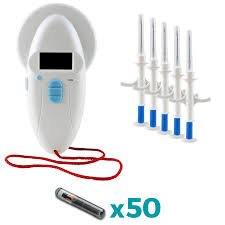
How to Set Up a Stationary PIT Tag Reader in Rivers: A Complete Step-by-Step Guide
Setting Up a Stationary PIT Tag Reader in Rivers: Step-by-Step Guide
Tracking fish movement through rivers is essential for conservation, fisheries management, and long-term ecological studies. And when it comes to monitoring individual fish over time, Passive Integrated Transponder (PIT) tagging is one of the most reliable methods. But tagging is only half the equation. To collect meaningful data, researchers must set up a stationary tag reader system in the field—one that’s rugged, waterproof, and precisely installed.
If you’re a fisheries biologist, environmental consultant, or student researcher looking to set up your first tag detection array, this guide walks you through the process—step by step.
Let’s dive into how to plan, install, and maintain a stationary tag reader system for river environments, ensuring you get accurate, high-quality fish detection data.
Why Use a Stationary Tag Reader?
While mobile readers are great for quick surveys or hatchery scans, stationary readers provide continuous, automated monitoring of fish as they pass a fixed point. This setup is ideal for:
- Tracking migration timing
- Measuring survival rates
- Evaluating fish ladder efficiency
- Monitoring tagged releases
In high-traffic areas like spawning routes or culverts, stationary systems can detect thousands of individual fish movements over time with minimal human intervention.
Before heading into the field, make sure you have the right equipment. A complete PIT tag reader system typically includes:
- Antenna – Usually a pass-through loop or flat panel, depending on river width and fish behavior.
- Reader Unit – The brain of the system. It powers the antenna and logs tag detections.
- Power Supply – Solar panels, batteries, or AC power depending on the site.
- Data Logger – Stores and timestamps tag detections.
- Enclosures – Waterproof boxes or vaults to protect electronics.
- Cabling & Connectors – Shielded cables to minimize interference.
- Anchoring Materials – Rebar, PVC, or custom frames to secure the antenna to the riverbed.
- Grounding Rods – To protect from electrical surges.
Popular commercial systems include Destron Fearing, Oregon RFID, and Biomark equipment, all of which are designed for aquatic research.
Step-by-Step Installation Guide
Step 1: Site Selection
Choosing the right location is critical. Your site should:
- Funnel fish through a narrow area (e.g., a weir, culvert, or fish ladder)
- Have stable riverbed conditions
- Be accessible for periodic maintenance
- Allow for safe power setup and data retrieval
Avoid areas with excessive turbulence, deep sediment, or high debris loads, which can interfere with signal strength or damage your antenna.
Step 2: Antenna Design & Assembly
Depending on the width of the stream and fish behavior, you’ll likely use one of two types of antennas:
- Loop Antennas: PVC or fiberglass frames in rectangular or circular shapes
- Flat Panel Antennas: Mounted flush with the riverbed or within structures
Assemble your antenna with appropriate waterproof materials and check for continuity using a multimeter. Be sure the wiring matches your reader unit’s configuration.
Step 3: Install and Anchor the Antenna
Once your antenna is tested, install it in the river channel. Use:
- Rebar stakes or sandbags for anchoring
- Submersible zip ties or stainless clamps for securing cables
- Flexible conduit to protect wiring from abrasion
Position the antenna so fish must pass directly through it—this increases your read rate and reduces missed detections. You may need to build a baffle or guide chute.
Step 4: Set Up the Reader Unit
Mount the tag reader unit on dry ground, ideally in a weatherproof enclosure or vault. Connect:
- Antenna leads to the reader inputs
- Power supply (battery/solar/AC)
- Optional GPS or remote telemetry
Ensure your reader is logging to onboard memory or connected to a telemetry system (cellular or satellite) for remote data access.
Step 5: Power & Grounding
Use solar panels for off-grid sites. Choose panels with 12V or 24V output depending on your reader’s needs. Pair with deep-cycle marine batteries and a charge controller to regulate flow.
Install a grounding rod to protect against lightning or electrical surges—especially critical near flowing water.
Step 6: Test & Calibrate
Before leaving the site:
- Test with multiple PIT-tagged dummy fish
- Walk tagged fish through the antenna zone at different speeds and angles
- Check signal strength and range using the reader’s built-in diagnostics
Ensure detection range covers the full water column and that no dead zones exist.
Step 7: Secure the Enclosure & Set a Maintenance Schedule
Lock all electronics in a weather-sealed, tamper-proof box. Use camouflage if necessary to prevent vandalism.
Plan routine checks every 2–4 weeks, or more often during high flow events, to:
- Clear debris from antennas
- Check battery levels
- Download or review detection data
Data Output and Analysis
Most reader units log:
- Tag ID
- Date & time of detection
- Antenna channel
- Signal strength
This data can be imported into programs like Excel, R, or custom GIS tools to map fish movement, survival rates, and migration timing. Make sure your system is time-synced with other PIT arrays for networked studies.
Real-World Use Case: Columbia River Basin
In the Pacific Northwest, hundreds of stationary tag reader systems have been deployed throughout the Columbia River Basin to track PIT-tagged salmonids. These arrays provide over 30 million detections per year, enabling scientists to analyze smolt-to-adult return rates, migration delays, and hydropower impacts.
The region’s success hinges on well-maintained antenna networks installed in fish ladders, juvenile bypass systems, and estuarine channels.
Common Pitfalls to Avoid
- Loose or exposed cables: These can snag debris or be chewed by animals.
- Weak anchoring: Strong currents can shift or destroy antennas.
- Poor site selection: Installing in a wide or low-traffic area will yield few detections.
- Signal overlap: Antennas too close together may cause interference—space them adequately and configure channels separately.
Final Thoughts
Setting up a stationary PIT tag reader system in a river isn’t just about planting equipment—it’s about designing a smart, strategic data collection site that will stand up to the elements and deliver reliable, long-term insight into fish movement.
By following this guide and using commercial-grade equipment, researchers can generate high-quality data that supports fish passage studies, endangered species recovery, and sustainable fisheries management.
As with any field project, meticulous planning, proper gear, and regular maintenance will determine your success. When installed correctly, a stationary tag reader system can quietly record thousands of fish passages, revealing the hidden stories flowing beneath the surface.








